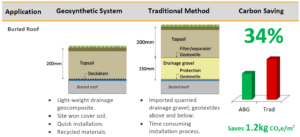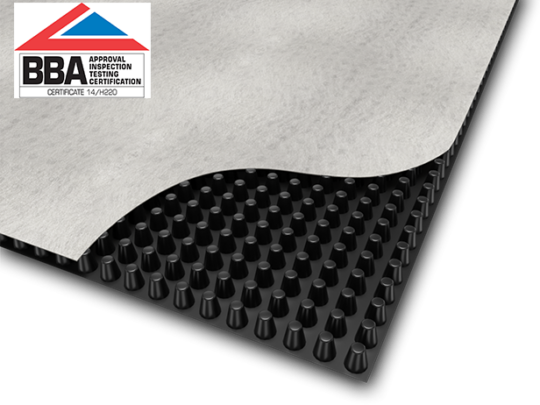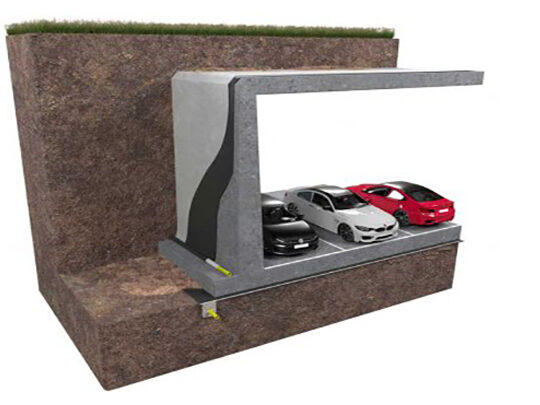Buried structures such as basements and retaining walls need drainage to reduce the build-up of water pressures and prevent ingress of groundwater into the structure. Traditionally this is achieved using a layer of porous drainage gravel. This may damage waterproofing layers and, in vertical applications, can be difficult to construct efficiently without a support system such as porous concrete blocks. Using a drainage geocomposite such as ABG Deckdrain is significantly easier to install, more cost effective and has a much lower carbon footprint.
Carbon Footprint Reduction: Drainage of Buried Structures


ABG Deckdrain Drainage Geocomposite
General Assumptions
The analysis method follows that described in the WRAP report (Corney, 2010). The carbon associated with four key stages is assessed a) the carbon associated with waste soil, b) the embodied carbon of imported materials, c) the transportation of imported materials to site, and d) the carbon associated with construction on site. For simplicity, the carbon footprint associated with excavation (including the carbon associated with waste soil) has not been included in these assessments – just the surfacing is compared.
The fuel efficiency of the vehicles used to transport geosynthetic products is assumed to be 4.4 miles/L (the measured fuel efficiency of ABG delivery trucks), and 2.2 miles/L for transport of soils on rigid trucks. The carbon footprint of burning diesel is assessed as 2.60 kgCO2e/L based on the value given for ‘Diesel (average biofuel blend)’ in the DEFRA report (Department for Environment Food & Rural Affairs, 2019).

The embodied carbon of the various imported non-geosynthetic materials is as per the ICE report (Hammond and Jones, 2011). The embodied carbon of all ABG Geosynthetic products is based on ABG internal assessments (Heritage, 2019), and for other geosynthetics it is based on ‘Obtaining reliable embodied carbon values for geosynthetics’ (Raja, 2015).
The transportation of imported materials is based on the installation site being 150 miles from ABG and 10 miles from the nearest quarry. The weight of material transported varies for each item. The carbon footprint associated with construction is based on estimates where possible and ignored in more complicated situations for simplicity of calculations.
Where assessed, the carbon footprint associated with construction is based on burning diesel at 2.60 kgCO2e/L (Department for Environment Food & Rural Affairs, 2018). An estimate of vehicle hours with a fuel efficiency of 25L/hr per vehicle is used to assess the quantity of diesel used.

Buried Roof
This assessment was based on a drainage stone solution compared with the use of ABG Deckdrain. In both cases the embodied carbon of the waste material is ignored. So the total carbon footprint is based on the embodied carbon of the materials, the transportation to site and emissions during construction (see ‘General Assumptions’).
The drainage stone solution is assumed to be a 150mm thick layer of single size 20-40mm stone, with a 200mm thick layer of topsoil above. There is a 300 gsm non-woven protection geotextile below the drainage stone to protect the waterproofing, and a 110 gsm non-woven filter geotextile above to prevent fine material from clogging the drainage stone. The embodied carbon of the drainage stone is assumed to be 0.0052 kgECO2e/kg (kilograms of embodied carbon dioxide equivalent per kilogram of product) as per the ICE report (Hammond and Jones, 2011) for ‘Aggregate – General (Gravel or Crushed Rock)’. The non-woven geotextiles are assumed to be 2.35 kgECO2e/kg (Raja, 2015). The embodied carbon of the topsoil is assumed to be zero due to grass growth during the lifetime of the installation. Standard assumptions (see above) have been made about the transportation of materials to site, other than the topsoil which is assumed to be site won and an indicative 1 mile of transportation is assumed to account for moving the topsoil around the site. Construction time estimates are all based on 40 hrs per hectare to place a 200mm thick layer of soil, and 25 hrs per hectare to place a layer of geotextile (Athanassopoulos & Vamos, 2011). Two machines are assumed to be required for the gravel (dozer and excavator), one for the topsoil and one for each geotextile layer.
The ABG solution is 200mm of topsoil over ABG Deckdrain 1200S/NW8. The embodied carbon of the topsoil is assumed to be site won and hence has a negligible embodied carbon, the ABG Deckdrain is 1.85 kgECO2e/kg (Heritage, 2020). Standard assumptions (see above) have been made about transporting the Deckdrain to site, and the topsoil is assumed to be site won with an indicative 1 mile of transportation assumed to account for moving the topsoil around the site. Construction time estimates are all based on 40 hrs per hectare to place a 200mm thick layer of soil, and 25 hrs per hectare to place a layer of geosynthetic (Athanassopoulos & Vamos, 2011). One machine is assumed to be required for the topsoil, and one for the Deckdrain.
Back of Wall Drainage
Carbon saving taken directly from the Costain case study (Wilson, 2018) which is a case study comparing the use of ABG Deckdrain with traditional solutions for drainage behind concrete bridge abutment retaining walls. The traditional solutions assessed were no-fines concrete and hollow concrete blocks backfilled with gravel. The carbon saving stated is based on hollow concrete blocks. The assessment in the case study discounted the removal of waste material, was based on actual distances to quarries/suppliers and material quantities as assessed by Costain.
Carbon Standard
The Carbon Footprint Standard logo shown below demonstrates that ABG’s carbon footprint assessments have been verified by Carbon Footprint Ltd. This verification covers both the company footprint in accordance with ISO 14064-3 (Fernandez, 2020a), as well the footprint of all ABG’s products (Fernandez, 2020b).
References
Athanassopoulos, C., & Vamos, R. (2011) Carbon footprint comparison of GCLs and Compacted Clay Liners. In Geo-Frontiers 2011. Dallas
Corney, N. et. al. (2010) Sustainable Geosystems in civil engineering applications, WRAP Geosystems Report MRF116-001
Department for Environment Food & Rural Affairs (2018). UK Government GHG Conversion Factors for Company Reporting
Fernandex, J. (2020a) Carbon Footprint Verification Report for ABG Geosynthetics Ltd, Carbon Footprint Ltd.
Fernandex, J. (2020b) Product Footprint Methodology Verification for ABG, Carbon Footprint Ltd.
Hammond, G. & Jones, C. (2011) Inventory of Carbon & Energy (ICE) Version 2.0, Sustainable Energy Research Team (SERT) Department of Mechanical Engineering, University of Bath, UK
Heritage, R. (2018) Assessed Carbon Footprint of ABG Products, ABG Geosynthetics Ltd [Accessed 4 May 2020]
Raja, J., Dixon, N., Fowmes, G., Frost, M. and Assinder, P. (2015). Obtaining reliable embodied carbon values for geosynthetics. Geosynthetics International. [http://dx.doi.org/10.1680/gein.15.00020]